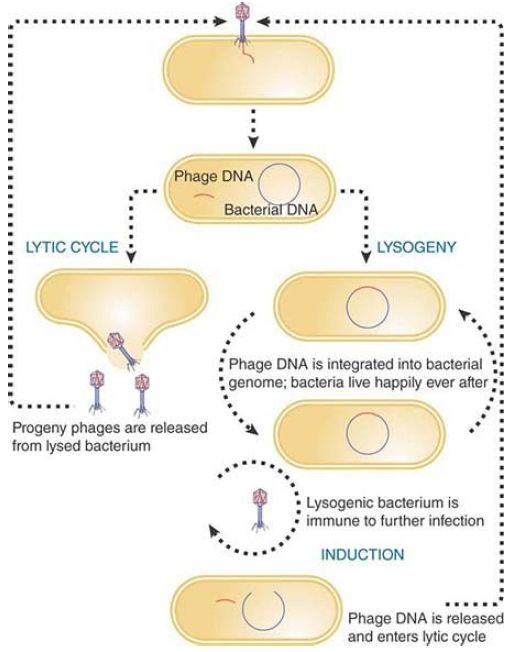

النبات

مواضيع عامة في علم النبات

الجذور - السيقان - الأوراق

النباتات الوعائية واللاوعائية

البذور (مغطاة البذور - عاريات البذور)

الطحالب

النباتات الطبية


الحيوان

مواضيع عامة في علم الحيوان

علم التشريح

التنوع الإحيائي

البايلوجيا الخلوية


الأحياء المجهرية

البكتيريا

الفطريات

الطفيليات

الفايروسات


علم الأمراض

الاورام

الامراض الوراثية

الامراض المناعية

الامراض المدارية

اضطرابات الدورة الدموية

مواضيع عامة في علم الامراض

الحشرات


التقانة الإحيائية

مواضيع عامة في التقانة الإحيائية


التقنية الحيوية المكروبية

التقنية الحيوية والميكروبات

الفعاليات الحيوية

وراثة الاحياء المجهرية

تصنيف الاحياء المجهرية

الاحياء المجهرية في الطبيعة

أيض الاجهاد

التقنية الحيوية والبيئة

التقنية الحيوية والطب

التقنية الحيوية والزراعة

التقنية الحيوية والصناعة

التقنية الحيوية والطاقة

البحار والطحالب الصغيرة

عزل البروتين

هندسة الجينات


التقنية الحياتية النانوية

مفاهيم التقنية الحيوية النانوية

التراكيب النانوية والمجاهر المستخدمة في رؤيتها

تصنيع وتخليق المواد النانوية

تطبيقات التقنية النانوية والحيوية النانوية

الرقائق والمتحسسات الحيوية

المصفوفات المجهرية وحاسوب الدنا

اللقاحات

البيئة والتلوث


علم الأجنة

اعضاء التكاثر وتشكل الاعراس

الاخصاب

التشطر

العصيبة وتشكل الجسيدات

تشكل اللواحق الجنينية

تكون المعيدة وظهور الطبقات الجنينية

مقدمة لعلم الاجنة


الأحياء الجزيئي

مواضيع عامة في الاحياء الجزيئي


علم وظائف الأعضاء


الغدد

مواضيع عامة في الغدد

الغدد الصم و هرموناتها

الجسم تحت السريري

الغدة النخامية

الغدة الكظرية

الغدة التناسلية

الغدة الدرقية والجار الدرقية

الغدة البنكرياسية

الغدة الصنوبرية

مواضيع عامة في علم وظائف الاعضاء

الخلية الحيوانية

الجهاز العصبي

أعضاء الحس

الجهاز العضلي

السوائل الجسمية

الجهاز الدوري والليمف

الجهاز التنفسي

الجهاز الهضمي

الجهاز البولي


المضادات الميكروبية

مواضيع عامة في المضادات الميكروبية

مضادات البكتيريا

مضادات الفطريات

مضادات الطفيليات

مضادات الفايروسات

علم الخلية

الوراثة

الأحياء العامة

المناعة

التحليلات المرضية

الكيمياء الحيوية

مواضيع متنوعة أخرى

الانزيمات
Introduction to Phage Strategies
المؤلف:
JOCELYN E. KREBS, ELLIOTT S. GOLDSTEIN and STEPHEN T. KILPATRICK
المصدر:
LEWIN’S GENES XII
الجزء والصفحة:
5-6-2021
2377
Introduction to Phage Strategies
A virus consists of a nucleic acid genome contained in a protein coat. In order to reproduce, the virus must infect a host cell. The typical pattern of an infection is to subvert the functions of the host cell for the purpose of producing a large number of progeny viruses. Viruses that infect bacteria are generally called bacteriophages, often abbreviated as phages or simply ϕ.
Usually, a phage infection kills the bacterium. The process by which a phage infects a bacterium, reproduces itself, and then kills its host is called lytic infection. In the typical lytic cycle, the phage DNA (or RNA) enters the host bacterium, its genes are transcribed in a set order, the phage genetic material is replicated, and the protein components of the phage particle are produced. Finally, the host bacterium is broken open (lysed) to release the assembled progeny particles by the process of lysis. For some phages, called virulent phages, this is their only strategy for survival.
Other phages have a dual existence. They are able to perpetuate themselves via the same sort of lytic cycle in what amounts to an open strategy for producing as many copies of the phage as rapidly as possible. They also have an alternative form of existence, though, in which the phage genome is present in the bacterial genome in a latent form known as a prophage. This form of propagation is called lysogeny, and the infected bacteria are known as lysogens. Phages that follow this pathway are called temperate phages.
In a lysogenic bacterium, the prophage is inserted, or recombined, into the bacterial genome and is inherited in the same way as bacterial genes. The process by which it is converted from an independent phage genome into a prophage that is a linear part of the bacterial genome is described as integration. By virtue of its possession of a prophage, a lysogenic bacterium has immunity against infection by other phage particles of the same type.
Immunity is established by a single integrated prophage, so in general a bacterial genome contains only one copy of a prophage of any particular type.
Transitions occur between the lysogenic and lytic modes of existence. FIGURE .1 shows that when a temperate phage produced by a lytic cycle enters a new bacterial host cell it either repeats the lytic cycle or enters the lysogenic state. The outcome depends on the conditions of infection and the genotypes of the phage and the bacterium.

FIGURE .1 Lytic development involves the reproduction of phage particles with destruction of the host bacterium, but lysogenic existence allows the phage genome to be carried as part of the bacterial genetic information.
A prophage is freed from the restrictions of lysogeny by a process called induction. First, the phage DNA is released from the bacterial chromosome by another recombination event called excision; the free DNA then proceeds through the lytic pathway.
The alternative forms in which these phages are propagated are determined by the regulation of transcription. Lysogeny is maintained by the interaction of a phage repressor with an operator. The lytic cycle requires a cascade of transcriptional controls. The transition between the two lifestyles is accomplished by the establishment of repression (lytic cycle to lysogeny) or by the relief of repression (induction of lysogen to lytic phage). These regulatory processes provide a wonderful example of how a series of relatively simple regulatory actions can be built up into complex developmental pathways.
 الاكثر قراءة في مواضيع عامة في الاحياء الجزيئي
الاكثر قراءة في مواضيع عامة في الاحياء الجزيئي
 اخر الاخبار
اخر الاخبار
اخبار العتبة العباسية المقدسة

الآخبار الصحية















 قسم الشؤون الفكرية يصدر كتاباً يوثق تاريخ السدانة في العتبة العباسية المقدسة
قسم الشؤون الفكرية يصدر كتاباً يوثق تاريخ السدانة في العتبة العباسية المقدسة "المهمة".. إصدار قصصي يوثّق القصص الفائزة في مسابقة فتوى الدفاع المقدسة للقصة القصيرة
"المهمة".. إصدار قصصي يوثّق القصص الفائزة في مسابقة فتوى الدفاع المقدسة للقصة القصيرة (نوافذ).. إصدار أدبي يوثق القصص الفائزة في مسابقة الإمام العسكري (عليه السلام)
(نوافذ).. إصدار أدبي يوثق القصص الفائزة في مسابقة الإمام العسكري (عليه السلام)


















